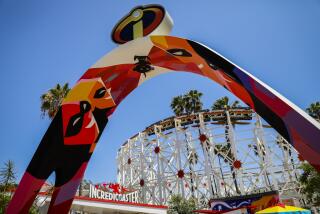Try riding a roller coaster to dislodge those painful kidney stones

A Michigan State University urologist reported that riding a medium-intensity roller coaster can result in the painless passing of small, and even a few large, kidney stones.
Just ask any one of the 300,000 Americans who, in any given year, develop kidney stones: What if the excruciating pain of passing one of those little devils could be prevented by strapping yourself into a make-believe runaway mine train, throwing your hands in the air and enduring G-forces as high as 2.5 for about three minutes? Would you do it?
Hell yeah, they’d do it.
In a bit of medical research inspired by strange and remarkable patient accounts, a Michigan State University urologist reports that, yes, riding a medium-intensity roller coaster such as the Disney theme parks’ Big Thunder Mountain Railroad can result in the painless passing of small, and even a few large, kidney stones.
For best results, ride in the back, where — roller coaster afficionados all seem to agree — the thrills are greatest. Independent of kidney stone volume and location, findings reported Sunday in the Journal of the American Osteopathic Assn. showed that sitting in the back of the roller coaster resulted in an average passage rate of 63.89%.
Front-seat rides resulted in a far more modest passage rate of 16.67%.
In what magical kingdom, you may well ask, does someone think to conduct such research?
Dr. David D. Wartinger, a professor emeritus at Michigan State University’s College of Osteopathic Medicine, initiated the study after a series of patients reported something almost too strange to believe: In the wake of riding Big Thunder at Walt Disney World in Orlando, Fla., these patients said their kidney stones passed painlessly from the kidney through the narrow duct of the ureter and into the bladder.
In one case, a patient told Wartinger that he passed one kidney stone after each of three consecutive rides on the roller coaster.
Using a 3-D printed model of that patient’s kidney, Wartinger and his colleagues implanted three kidney stones of various sizes into the upper, middle or lower passageways of the clear silicone model.
Two of those mineral clusters, which can form as the kidney filters waste from the bloodstream, were small-to-moderate size — 4.5 millimeters and 13.5 mm. Those might pass through the duct leading to the bladder without incident but could also cause considerable pain and discomfort as they passed unaided. But a third measured 64.6 mm, a size that would rarely pass without treatment — the administration of ultrasound shock waves, called lithotripsy, designed to break up the deposit and allow it to pass.
The researchers received permission from Walt Disney World first, then concealed the kidney model in a backpack and rode Big Thunder 20 times, varying their seat position between front and back.
After analyzing the location of those three kidney stones at the end of each ride, the researchers concluded that “findings support the anecdotal evidence that a ride on a moderate-intensity roller coaster could benefit some patients with small kidney stones,” Wartinger said. When the kidney stone was large, the initial position of the kidney stone affected the likelihood of its passing during the ride. But even those passed two in three times while the silicone model rode the thrill ride.
“Many people in the United States probably live within a few hours’ drive of an amusement park containing a roller coaster with features capable of dislodging calyceal renal calculi,” wrote Wartinger and co-author Dr. Marc A. Mitchell of the Doctor’s Clinic in Poulsbo, Wash.
Roller coaster therapy might be a good preventive treatment for people who are at high risk of developing obstructive kidney stones, wrote Wartinger and Mitchell. They suggested that patients who have had kidney stones in the past, or women who have had kidney stones and are thinking of becoming pregnant, consider a thrill ride or two in a bid to clear tiny stones before the deposits grow larger. Kidney stone sufferers who have had their deposits broken up by lithotripsy might also consider a roller-coaster ride to finish the job, they said.
Follow me on Twitter @LATMelissaHealy and “like” Los Angeles Times Science & Health on Facebook.
MORE IN SCIENCE
United Nations takes on antimicrobial resistance
How scientists virtually unwrapped an ancient, burned scroll and read the words inside
Studies on the perils of polyester underwear and the personality of rocks win Ig Nobel Prizes







